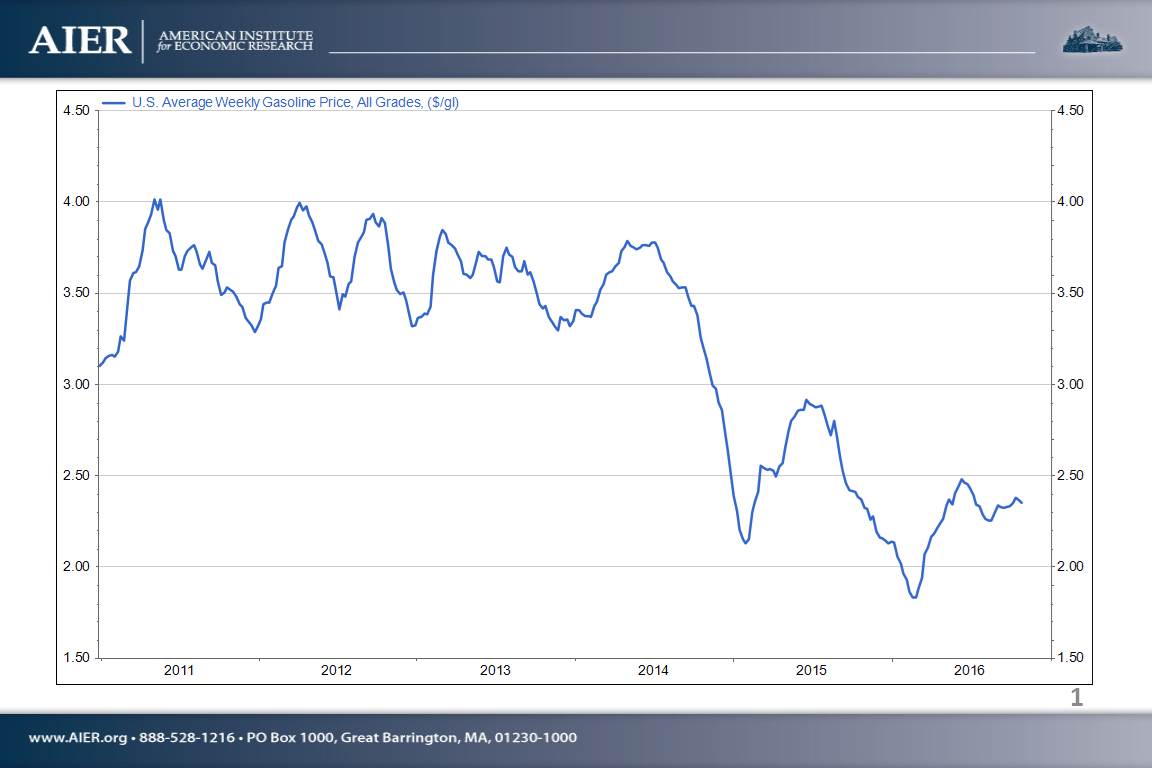How Much Do Gas Prices Matter When Buying a Car?
Our beloved green Saturn had finally reached the end of its working life, and it was time to find some new wheels. This was 2012, and my wife and I wanted to find a car we could love as much. As hybrids were becoming more pervasive, and with gas prices rapidly climbing, we decided to check out a Prius C at the local Toyota dealership.
The car cost about $3,000 above a Corolla, a comparably sized Toyota with a traditional engine. But the salesman was ready to address this concern.
He took out a calculator, a pad and pen. Gas was at $4 per gallon, and – I remember the confidence in his eye and voice — he said it wouldn’t be going down. The Prius got an average of 50 miles per gallon, compared to the 30 average MPG of the Corolla. We’d actually end up saving money well before the end of the five-year payment period by spending less on gas, he said.
His pitch was audacious. How could a car salesman, much less a trained economist, be able to predict the price of gas over a five-year period? We were unsold on his pitch, and despite the Prius’ environmental appeal, we didn’t want to wait several years to start saving money. Eventually we opted for the Corolla-like Mazda 3, with a traditional engine.
Of course, the salesman was wrong. The price of gas did go down, by quite a bit. Gas prices fell for many reasons, most notably discoveries of abundant reserves of domestic shale oil and gas.
I don’t blame the salesman for being a poor forecaster. His job was to convince me to buy a car. But in the ensuing years, as I passed gas stations that advertised prices well below $4, I continued to marvel at his audacity.
Recently I turned to my colleague Bob Hughes, a senior research fellow here at the American Institute for Economic Research, to help me quantify the salesman’s overreach. Bob consulted the Energy Information Administration database to find the weekly average price of gasoline from 2012 until today. On April 12, 2012, the day we took our test drive, the price per gallon was $4, right on the money.
But by Thanksgiving 2014, the price of gas had fallen below $3. By Valentine’s Day 2015, it was $2.30. A year later, it was $1.87. Last week it was $2.36. Over the four-and-a-half years since we test drove the Prius, the average price of gas has been $3.127, or about 87 cents per gallon less than the $4 quoted by the salesman.
If my wife and I had bought the Prius and driven 15,000 miles per year over the five-year payment period, we would have spent $6,000 on gas, at an average of $4 a gallon. But at $3.127 per gallon, we would have spent just $4,691.
The Corolla, meanwhile, would have cost us $10,000 in gas over those five years at $4 a gallon. But at $3.127 a gallon, we would have instead spent $7,818.
So in reality, the gasoline savings over five years of driving the Prius would have been just over $3,000. It would have taken us the full five years to break even.
This is a rough estimate, glossing over factors like highway vs. city driving, and the fact that unlike most Americans, I drive a lot more miles than 15,000 per year, most of them highway. So I would have saved more on gas.
But we opted for a more traditional vehicle because it was cost-effective at the point of sale. Gasoline prices were, and will always be, a variable. We wanted to be environmentally responsible and financially forward thinking, but at the end of the day, we needed a reliable, comfortable car, something with a reasonable down payment and smaller fixed monthly payments. And yes, I liked the stereo.
Saving money on gas doesn’t tend to be what motivates people to buy any particular car, said John Voelcker, editor of GreenCarReports.com. People tend to let it affect their choice if they see a quick runup in gas prices. But those same consumers might not even notice the same increases if they happened gradually, he said.
If people can pay back their investment on a hybrid or electric car within 18 months, savings on gasoline become much more convincing in choosing a car, he said. But “a payback in year five doesn’t feel like a good value,” he said.
“People say they want fuel economy, but first and foremost, they want to buy a car that meets their needs. Fuel economy is pretty far down the list,” Voelcker said.









